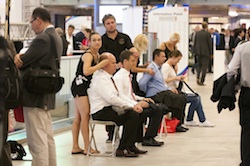
The purpose of our multi-writer IBC Wrap-Up section in our November issue (starting page 26) is to tease out the trends and directions behind the big industry drivers at the event, across Ultra HD emergence, IT broadcast workflows, multi-platform content distribution and second screen strategies.
Mark Hill says that ‘just as enthusiasm for 3D was waning this year, interest in big pictures was waxing’ – and the bit rates required for big picture delivery will ‘surely signal the death knell for copper cable-based infrastructure and conventional cross-point routing’.
For David Kirk, the big story at IBC2012 was about ‘prices rather than technology. The adoption of software-based systems running on mass-produced computer platforms has unleashed unstoppable momentum in file-based editing and MAM, accelerated by the transition to file-based content capture’. Kirk says signs of affordable 4K Ultra HD infrastructure are already appearing on the market – well ahead even of industry estimates made at NAB.
Ian McMurray observes that 10 July 2012 marked the fiftieth birthday of the first ever TV broadcast by satellite. At IBC, the excitement in the satellite world revolved around Ka-band, which offers increased spectrum and potential traffic compared to C-band and Ku-band.
IBC saw an array of new cameras and camera links (wired and wireless) launched onto the market. David Fox brings us the best of the new entries, and remarks, ‘even as broadcasters are just arriving at 1080p 50/60 HD, camera manufacturers are looking beyond that for the next big thing, which is, naturally, big – bigger sensors and bigger images, principally 4K’.
From acquisition and programme-making, through post and packaging to distribution, ad sales and sponsorship, good media management is cited as pivotal to future success, writes Russell Grute — whether that’s feeding existing audiences more cost effectively or trying to win new audiences in new places. So did IBC make things any clearer about more efficient and cost effective media management?
Plenty of ‘big’ industry issues to reflect on in this month’s edition, with our IBC Wrap-Up team. In the noise generated by the IBC show, one interesting piece of high-level research may have escaped your notice. The Avid broadcast survey was conducted from July through August 2012 by Ovum Research; over 200 decision makers from broadcast and post organisations in Europe and North America were interviewed.
Among key findings were that two thirds of executives believe the industry will grow over the next five years. 85% believe multi-platform distribution is critical to capturing new growth opportunities – and 78% think that within 10 years, most content will be customised based on the profile attributes of individual viewers.
The top three drivers for growth were identified by the Avid survey as increased audiences, multi-platform distribution and growth in ad revenues. Over three-quarters of respondents believed the internet will actually drive audiences to watch more broadcast/cable/satellite TV.
On more immediate broadcast/post infrastructure topics, two-thirds said asset-based workflows will enable new business models, and over 70% said they will result in OPEX savings. While just 23% of respondents are using a cloud infrastructure today, over 75% are exploring cloud deployment. Cloud was viewed by respondents as an enabler for new business and distribution models; a means to reduce infrastructure costs; and to enable new collaborative workflows.
Announcing the survey results, Avid CEO and Chairman Grary Greenfield commented, “This change in the relationship between broadcasters and their audiences also forces a change in business models — and places new demands on how compelling content is created, managed and delivered.”
The consumer view
Understanding that changing relationship between broadcasters and their customers is critical to every content owner and media organisation. But how do the ‘customers’ see it?
Just after IBC, Red Bee Media worked with digital media consultancy Decipher to poll more than 2,000 smart device owners across the UK on viewing habits and attitudes towards dual screen activity.
The poll found that 86% of smart device owners have used their phone, tablet or computer while watching TV. 52% of respondents have used a second screen to find out more about a TV programme. And one third of smart device owners say they’re more likely to watch a show live rather than on-demand if there is significant social buzz around that programme.
However, only 19% of respondents positively rate their ability to engage with TV shows. This would strongly suggest that most broadcasters have plenty of work to do in order to make the second-screen experience seamless with the first.
On the flip side, respondents who have used synchronous companion apps do like them. 78% think smart devices are a better way to engage with favourite TV shows — the most popular activities being polls or voting (55%) and the ability to participate/play along (52%).
So, can dual screening be used to generate revenue streams for broadcasters? The survey found that 44% of dual screeners already use their second screen to find out more about brands or advertising. 56% are open to receiving targeted ads through synchronous apps based on products featured on TV, and 30% would be more inclined to engage with ads if offered via a smart device while watching TV.
On the findings, Stella Medlicott from Red Bee Media said, “There is no doubt that second screening is here to stay… This new behaviour represents a fantastic opportunity for broadcasters, platforms and content owners to take their engagement with viewers beyond the primary TV screen and monetise it. The challenge for us, though, as an industry, is to understand how we can work together to devise a business model that works right across the value chain.”
By Fergal Ringrose






